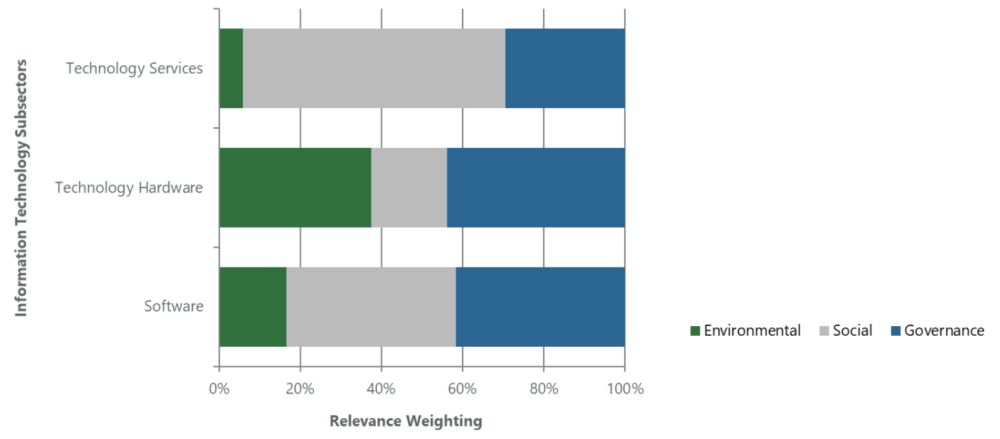Low correlation among third-party ESG ratings providers can be an important signal for investors. Relying heavily on such ratings could lead to very different portfolio outcomes, and differing opinions from third-party ESG ratings agencies can create confusion for clients or investors. This issue supports the case for not relying solely on ratings agencies and speaks to the importance of knowing what you own.
To know what you own, it is first necessary to develop an understanding of a company’s ESG characteristics through one’s own fundamental analysis. This is where proprietary ESG ratings can come into play and provide benefits for stakeholders. Many analysts may find a deeper understanding and analysis of all elements of “ESG” — environmental performance, social factors, and corporate governance practices — better enables informed opinions and engagement. For example, social factors such as diversity, equity and inclusion (DEI), labor/hiring practices, community involvement and reputational issues can be complex and difficult to capture in scores, yet they inform the overall analysis of a company’s attractiveness as an investment and lend themselves to close knowledge of a company and the industry in which it operates.
Expressing this analysis in proprietary ESG ratings, then, provides an internally consistent metric that is both quantitative and qualitative to help measure and analyze a company’s sustainability risks and opportunities. Investors doing this work themselves may see several benefits, including information advantages, risk-reward value and impact potential through benchmarking.
1. The Information Advantage of Proprietary ESG Ratings
Analyzing the ESG characteristics of companies involves using both quantitative and qualitative measures of what is most material and relevant to each company’s industry. In some cases, industrywide data is typically available, such as carbon emissions levels in the utilities sector or employee safety data in the industrials sector; in other cases, however, the analyst must derive primary company research from direct analysis.
Published research and public disclosures factor into the formation of ESG ratings, but so too should face-to-face meetings and engagements with companies and industry-specific experience. This proprietary work helps determine which specific environmental, social and governance issues are relevant for each company (Exhibit 1). Direct conversations, in a dynamic and symbiotic dialogue with company leadership often over several years, can add perspectives that create an information advantage — one a fundamental analyst with deep knowledge of the company will also have an advantage in using. This information advantage is particularly important in the case of widely owned stocks that present complex sustainability stories, such as large tech platforms Amazon.com, Apple and Google.
Exhibit 1: ClearBridge ESG Materiality Framework™ Sample

2. Proprietary Ratings Capture Risk-Reward Information, but Are Not Synonymous with It
ESG analysis, expressed in a rating, should be a critical part of the normal due diligence performed in fundamental analysis, which we do as part of our process to help find quality companies with sound fundamentals. At the same time, ESG ratings may highlight ESG-specific factors to be better compared and understood.
Although ESG ratings factor into investment recommendations, ratings by themselves are not recommendations to buy or sell a stock. Nevertheless, we have found they contribute to performance. In recent studies of performance and fundamental characteristics of ClearBridge’s ESG-rated stocks published with the UN-supported Principles for Responsible Investment (PRI), we found that higher ESG-rated stocks:
- Outperformed the market more frequently than lower ESG-rated stocks.
- Generated higher risk-adjusted returns (as measured by their Sharpe ratios) than lower ESG-rated stocks, with AAA and AA stocks generating higher risk-adjusted returns than the S&P 500 Equal-Weight Index.
- Generated higher alpha than lower ESG-rated stocks after accounting for common factor exposures including market beta, size, value, momentum and quality.
These studies show how a proprietary ESG ratings system developed by fundamental investors appears to contribute to performance and have an added benefit beyond that which could be explained by common quantitative factors and fundamental financial metrics.
3. Benchmarking for Impact
Proprietary ESG ratings are a tool to communicate to portfolio managers our confidence in or expectations for progress on ESG issues. In addition to informing the investment decisions of portfolio managers, these also guide how we use client capital to seek to make an impact in the companies where we invest.
In sectors where proprietary research has identified an industry leader in sustainable practices, labor and workplace policies or other ESG factors, we will often use that company as a benchmark for quantitative and/or qualitative comparison. We also share best practices during company engagements, recognizing companies may benefit from ideas we offer and feedback we provide on key issues. Examples include feedback on DEI disclosure to help contribute to managements’ understanding of their employee talent pool; recommendations on executive compensation pay practices; and support for decarbonization strategies being employed sooner rather than later.
Third-party ESG ratings can be a valuable input, of course, and there are many innovators in responsible investing helping improve the quality of data and deepen the ESG knowledge base. But insofar as ESG ratings can benefit from fundamental analysis, which offers information advantages, captures risk/reward information and underpins engagement, developing them primarily from one’s own fundamental analysis makes a lot of sense.
RIA Disclaimer
The views and opinions expressed in this article are solely those of the authors and do not necessarily reflect the view or position of the Responsible Investment Association (RIA). The RIA does not endorse, recommend, or guarantee any of the claims made by the authors. This article is intended as general information and not investment advice. We recommend consulting with a qualified advisor or investment professional prior to making any investment or investment-related decision.

